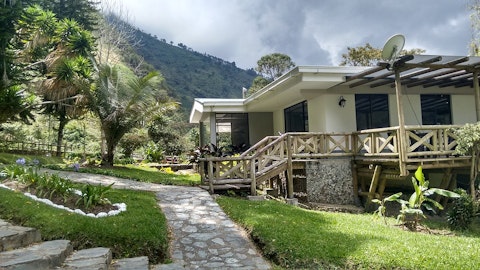Apple Hospitality REIT, Inc. (NYSE:APLE) Q4 2023 Earnings Call Transcript February 23, 2024
Apple Hospitality REIT, Inc. isn’t one of the 30 most popular stocks among hedge funds at the end of the third quarter (see the details here).
Operator: Greetings and welcome to the Apple Hospitality REIT Fourth Quarter and Full Year 2023 Earnings Call. At this time, all participants are in a listen-only mode. [Operator Instructions] As a reminder, this conference is being recorded. I would now like to turn the conference over to your host Kelly Clarke, Vice President, Investor Relations for Apple Hospitality REIT. Thank you, you may begin.
Kelly Clarke: Thank you and good morning. Welcome to the Apple Hospitality REIT’s fourth quarter 2023 earnings call. Today’s call will be based on the earnings release and Form 10-Q, which we distributed and filed yesterday afternoon. Before we begin, please note that today’s call may include forward-looking statements as defined by federal securities laws. These forward-looking statements are based on current views and assumptions and as a result, are subject to numerous risks, uncertainties, and the outcome of future events that could cause actual results, performance or achievements to materially differ from those expressed, projected or implied. Any such forward-looking statements are qualified by the risk factors described in our filings with the SEC, including in our 2022 annual report on Form 10-K and speak only as of today.
The Company undertakes no obligation to publicly update or revise any forward-looking statements, except as required by law. In addition, non-GAAP measures of performance will be discussed during this call. Reconciliations of those measures to GAAP measures and definitions of certain items referred to in our remarks are included in yesterday’s earnings release and other filings with the SEC. For a copy of the earnings release or additional information about the Company, please visit applehospitalityreit.com. This morning, Justin Knight, our Chief Executive Officer; and Liz Perkins, our Chief Financial Officer, will provide an overview of our results for the fourth quarter 2023 and an operational outlook for the remainder of the year. Following the overview, we will open the call for Q&A.
At this time, it is my pleasure to turn the call over to Justin.
Justin Knight: Good morning, and thank you for joining us today. We’re pleased to report another year of strong operating performance, portfolio growth, and total returns for our shareholders. During the year, operating fundamentals continue to strengthen, and we thoughtfully grew our portfolio with the acquisition of six hotels, enhanced the quality of our hotels through capital improvement projects, provided our shareholders with attractive distributions, and positioned our balance sheet for continued growth by raising net proceeds of $216 million through our ATM program. Our accomplishments in 2023 and our outperformance since the onset of the pandemic are a testament to the merits of our strategy of owning a diversified portfolio of rooms-focused hotels with broad consumer appeal while maintaining financial flexibility with low leverage and speak to the strength of the brands and management companies we work with and the diligent efforts of our experienced team.
With resilient leisure demand and steady improvements in business travel, we are pleased to report Comparable Hotels’ RevPAR growth of more than 2% for the fourth quarter and 7% for the full year 2023 as compared to the same periods of 2022, primarily driven by increases in Comparable Hotels’ ADR of nearly 3% and 5% respectively. Comparable Hotels’ occupancy for the fourth quarter of 2023 was essentially flat to the fourth quarter of 2022 and for the year was up approximately 2% as compared to 2022. Comparable Hotels’ adjusted hotel EBITDA was $104 million for the quarter and $500 million for the year, down 2% and up 5% respectively as compared to the same periods of 2022. Our portfolio continues to perform ahead of pre-pandemic levels with Comparable Hotels’ RevPAR up approximately 8% relative to both the fourth quarter and full year 2019, despite continued opportunity to rebuild occupancy, especially mid-week.
Comparable Hotels’ adjusted hotel EBITDA was up approximately 6% and 7% to the fourth quarter and full year 2019 respectively. Based on preliminary results, January Comparable Hotels’ occupancy increased just over 1% year over year and ADR grew over 2%. Overall, travel trends remained favorable with operating results continuing to be bolstered by limited near-term supply growth. We anticipate that we will be in a position to more meaningfully grow rate as we move through the first quarter and into seasonally stronger occupancy months. Our revenue and asset management teams continue to leverage our scale ownership of rooms-focused hotels and our unparalleled access to performance data to benchmark and share best practices across our third-party management companies to drive strong margins despite continued inflationary and wage pressures.
We are fortunate to be partnered with some of the best operators in the industry who monitor real-time performance and focus on-site efforts to maximize profitability at our hotels without sacrificing service, cleanliness, maintenance, or overall guest satisfaction. Through disciplined cost controls, we achieved Comparable Hotels’ adjusted hotel EBITDA margin of 32.9% for the quarter despite lower REVPAR growth and 36.4% for the full year. Supported by our strong operating performance, we continue to provide investors with strong dividend yield. We paid distributions totalling $0.24 per common share during the fourth quarter and $1.04 per common share during the year for a total of approximately $238 million. Based on Wednesday’s closing price, our annualized regular monthly cash distribution of $0.96 per share represents an annual yield of approximately 6%.
Together with our board of directors, we will continue to monitor our distribution rate and timing relative to the performance of our hotels and other potential uses of capital. During the fourth quarter, we sold approximately 12.8 million shares under our ATM program at a weighted average market sales price of approximately $17.05 per common share and received net proceeds of approximately $260 million. The $17.05 per share represents a 12.6x multiple on 2023 EBITDA, just under a turn and a half spread to the combined multiple for the five hotels we acquired in the fourth quarter. The proceeds were used to fund acquisitions and to reset our balance sheet, position us to be active in market, and to continue to pursue accretive opportunities.
In 2023, we acquired a total of six hotels and an associated parking deck for a total of approximately $290 million. As previously announced, in June, we acquired the Courtyard Cleveland University Circle for $31 million. In October, we acquired the Courtyard and Hyatt House Salt Lake City Downtown, together with a corresponding parking garage for a combined total of $91.5 million. We also acquired the Residence Inn Seattle South Renton in October for $55.5 million. In November, we purchased the Embassy Suite South Jordan Salt Lake City for a total of approximately $37 million. And in December, we acquired the Spring Hill Suites Las Vegas Convention Center for $75 million. We are pleased to expand and enhance our presence within these business-friendly markets that have seen significant economic growth and positive demographic trends in recent years.
These markets are home to a wide variety of business, group, and leisure demand generators, from healthcare, universities, technology, and manufacturing, to outdoor recreation, professional sporting events, and world-renowned entertainment. The hotels complement our existing portfolio and reflect our proven investment strategy. The combined purchase price for the recently acquired hotels represents a blended cap rate of just over 8% on 2023 year-end financials after an industry-standard 4% FF&E reserve, and an 11.3 times multiple on 2023 combined hotel EBITDA. We believe each of these assets is well-positioned within its respective market and has embedded upside that will enable it to be a meaningful contributor to our overall portfolio performance.
We continue to have two hotels under contract for purchase that are currently under development, an Embassy Suite in downtown Madison, Wisconsin for approximately $79 million, and a Motto in downtown Nashville for approximately $98 million. We anticipate acquiring the Madison Embassy in mid-2024 and the Nashville Motto in late 2025, both following completion of construction. Our patience over the past several years has positioned us to be active in a market with limited competition where we can secure high-quality assets at pricing that meets our internal underwriting criteria. Consistent with the strategy we articulated on past calls, we were able to fund a portion of our recent activity utilizing our ATM with equity issued at a spread to specific targeted acquisitions, positioning us to generate incremental value for our existing shareholders.
Having reset our balance sheet, we are exceptionally well-positioned to pursue additional accretive opportunities, and we continue to actively underwrite a number of potential acquisitions that could further enhance our unique and scalable platform and contribute to long-term shareholder returns. As has been the case historically, our acquisitions focus continues to be on high-quality branded, rooms-focused hotels in urban, high-density suburban, and developing markets supported by a broad variety of business and leisure demand drivers. Through our scale ownership of these hotels, broadly diversified across markets and demand generators, we have unparalleled access to performance, market, and brand data, which we believe enhances the underlying strength of our due diligence effort.
Combined with our tremendous transaction experience, our available balance sheet capacity, and our deep industry relationships, we believe we continue to be well-positioned relative to competitors in the current market environment and are optimistic that we will continue to be net acquirers in the coming months. We also actively seek opportunities to refine our portfolio and optimize our capital reinvestment program by disposing of older assets in lower-growth markets. Earlier this month, we sold a Hampton Inn and Homewood Suites located in Rogers, Arkansas for a combined total of $33.5 million. We anticipate a portion of the proceeds from the sale of these two hotels will be used to complete a 1031 exchange, which will result in the deferral of taxable gains of approximately $15 million.

The sales price represents an all-in 8.6% cap rate on 2023 year-end financials, assuming $5.4 million or approximately $22,000 per key in PIP related capital improvements. Since the onset of the pandemic, we have strategically transacted in ways that have refined and grown our portfolio. We have completed approximately $287 million in hotel sales and have invested approximately $848 million in new acquisitions while maintaining the strength of our balance sheet. These transactions have lowered the average age of our portfolio, increased revenue per available room and margins, helped to manage near-term CapEx needs and positioned us to continue to benefit from near-term economic and demographic trends. We also continue to reinvest in our existing portfolio to ensure our hotels remain competitive in their respective markets and are positioned to demand premium rates.
Over the past year, we invested approximately $77 million in capital expenditures. And in 2024, we expect to spend between $75 million and $85 million with major renovations at approximately 20 of our hotels. As we look ahead, the fundamentals of our business remain favorable, with continued strength in demand and limited new supply. As of year-end, over half of our hotels did not have any new upper — upscale or upper mid-scale product under construction within a 5-mile radius providing us with the ability to meaningfully benefit from incremental demand and positively impacting the overall risk profile of our portfolio by both reducing potential downside and enhancing the upside impact from variability in launching demand. Over the past several years, we have demonstrated the value of a scaled investment in a broadly diversified portfolio of rooms-focused hotels with low leverage.
We are confident that this same strategy will continue to enable us to drive strong performance for shareholders in the coming year and over time. Our hotels are franchised with industry-leading brands managed by some of the best management companies in the industry, and provide a strong value proposition with broad consumer appeal. Underlying the strength of our portfolio is a consistent reinvestment and effective portfolio management strategy and a dedicated corporate team with extensive industry experience. As we move further into 2024, we are optimistic about the trajectory of our industry and our portfolio specifically. It is now my pleasure to turn the call over to Liz for additional detail on our balance sheet, financial performance during the quarter and annual guidance.
Liz Perkins: Thank you, Justin, and good morning. We are pleased to report another strong quarter for our portfolio of hotels. Comparable Hotels total revenue was $315 million for the quarter and $1.4 billion for the year, up 3% and 7% as compared to the same period of 2022, respectively. Continued strength in leisure demand and recovery in business travel during the quarter enabled us to achieve Comparable Hotels RevPAR of $105 and $116 up 2% and 7% as compared to the same periods of 2022, with ADR of $151 and $157, up 3% and 5% and with occupancy of 70% and 74%, essentially flat and up 2% to fourth quarter and full year 2022, respectively. Looking day over day, leisure travel was resilient during the quarter with weekend occupancy stable compared to the fourth quarter of 2022, with continued improvement in business travel.
We anticipate leisure demand will remain stable through 2024 and that most of our growth in occupancy will come from continued improvement in weekday demand which, while elevated relative to the prior year remains meaningfully below pre-pandemic levels. Same-store room night channel mix remains relatively stable in the quarter with brand.com bookings at 40%, OTA bookings at 13%, PropertyDirect at 25% and GDS bookings at 16%. Our channel mix continue to highlight the power of our brands and the strength of our property direct sales efforts that our properties maintained in the field. Fourth quarter same-store segmentation was largely consistent with the third quarter. Bar remained strong at 33%. Other Discounts remained seasonally elevated at 30%.
Group continued to make up 14% of our mix, almost 200 basis points higher than the same period in 2019. And the negotiated segment was 17% of our mix, in line with the same period in 2022, but still lower than 2019, which we believe represents opportunity for continued upside. Turning to expenses total payroll per occupied room for our same-store hotels was under $41 for the quarter, up slightly to the third quarter 2023 and up 7% to the fourth quarter 2022. Contract labor remained stable at roughly 10% of wages during the quarter, a 13% improvement compared to the fourth quarter of 2022, while we expect year-over-year growth in total payroll to moderate in 2024, given more stabilized operations in 2023. We anticipate that higher wages for full and part-time employees and higher utilization of contract labor will continue to result in elevated cost per occupied room relative to pre-pandemic levels.
We achieved Comparable Hotels Adjusted Hotel EBITDA of approximately $104 million during the quarter and $500 million for the full year, down 2% and up 5% to the same periods of 2022, respectively. Comparable Hotels Adjusted Hotel EBITDA margin was 32.9% for the quarter and 36.4% for the year, down 160 basis points and 90 basis points to the same periods of 2022, respectively. As we have stated on past calls, our ability to maintain and potentially grow margin will be largely conditioned on our ability to grow rate. Though with more manageable inflation numbers and hotels appropriately staffed, we expect near-term growth in operating expenses to moderate relative to the significant increases we saw over the past year. Adjusted EBITDA for the fourth quarter was $91 million and for the year was $437 million, up 1% and 6% to the same periods of 2022, respectively.
MFFO for the quarter was $72 million and for the year was $367 million, down 3% and up 4% as compared to the same period of 2022, respectively. Looking at our balance sheet, as of December 31, 2023, we had approximately $1.4 billion in total outstanding debt net of cash. Approximately 3.1x our trailing 12 months EBITDA with a weighted average interest rate of 4.3%. Total outstanding debt, excluding unamortized debt issuance cost and fair value adjustments, was comprised of approximately $283 million in property-level debt secured by 15 hotels and approximately $1.1 billion outstanding on our unsecured credit facility. At year-end, our weighted average debt maturities were just under four years. We had cash on hand of approximately $10 million and availability under our revolving credit facility of approximately $650 million and approximately 89% of our total debt outstanding was fixed or hedged.
As of December 31, we had approximately $105 million of debt maturing in the next 12 months, consisting of one $85 million term loan and a mortgage loan of approximately $20 million. We plan to pay for these upcoming debt maturities using funds from operations, borrowings under our revolving credit facility and/or new financing. Acquisitions completed during the fourth quarter were funded using cash on hand, availability under our revolving credit facility and net proceeds from the sale of shares under our ATM program. As Justin highlighted in his remarks, during the quarter, we sold approximately 12.8 million shares under our ATM program at a weighted average sales price of approximately $17.05 per share and received aggregate gross proceeds of approximately $219 million and proceeds net of offering costs of approximately $216 million.
As of year-end, we had approximately $5 million remaining under our ATM program and are in process with our Board and agents to reauthorize and extend our ATM program. We anticipate public filings related to the program to be filed later today. With this successful capital raise during the quarter, we were able to grow our portfolio with the acquisition of 5 attractive high-quality hotels while maintaining full availability on our revolving credit facility to pursue additional accretive opportunities. Turning to our outlook for 2024 provided in yesterday’s press release. For the full year, we expect net income to be between $191 million and $217 million. Comparable Hotels RevPAR change to be between 2% and 4%. Comparable Hotels Adjusted Hotel EBITDA margin to be between 34.6% and 35.6% and Adjusted EBITDAre to be between $452 million and $474 million.
While our asset management and hotel teams are working diligently to mitigate cost pressures, we have assumed for purposes of guidance that hotel operating costs will increase by approximately 5% at the midpoint. This outlook is based on our current view and does not take into account any unanticipated developments in our business or changes in the operating environment, nor does it take into account any unannounced hotel acquisitions or dispositions. The high end of our full year range reflects relatively steady macroeconomic conditions through 2024 with continued strength in leisure demand and improvement in business transient. The low end of our range reflects more modest lodging demand growth with a slight pullback in leisure demand, offset by continued improvement in business transient and group.
It should be noted that because of calendar shifts with the Easter holiday and more challenging year-over-year comparisons driven by the 2023. Super Bowl in Phoenix, where we have meaningful portfolio concentration we anticipate first quarter performance for our portfolio to be below the low end of our range with performance improving as we move into higher occupancy months in the second and third quarters. As we begin 2024, we are pleased with our performance and confident, we are well positioned for the year. Our recent acquisition activity has enabled us to drive incremental value for shareholders despite challenges in the operating environment, which continue to put pressure on margin Implied modified funds from operations are up on a per share basis year-over-year at the midpoint and higher of our guidance range.
Our differentiated strategy has proven resilient through economic cycles. Our balance sheet is strong with ample liquidity, which we will continue to use opportunistically to pursue accretive transaction. Our assets are in good condition with consistent capital investments, ensuring that we maintain a competitive advantage over other products in our markets. And we believe the fundamentals of our business are sound, with favorable supply dynamics, allowing us to benefit from incremental demand. Our team will continue to work to maximize the performance of our existing assets and pursue external growth where we can achieve favorable pricing. That concludes our prepared remarks. Justin and I will now be happy to answer any questions that you have for us this morning.
Coordinator?
Operator: [Operator Instructions] Our first question comes from the line of Michael Bellisario with Baird. Please proceed with your question.
See also 15 Highest Quality Pizza Chains in America and 11 Best RV and Camping Stocks To Invest In.
Q&A Session
Follow Apple Hospitality Reit Inc. (NYSE:APLE)
Follow Apple Hospitality Reit Inc. (NYSE:APLE)
Michael Bellisario: Thanks. Good morning, everyone. Two questions for you. But first on capital allocation. I know you mentioned it briefly in your prepared remarks, but can you maybe big picture remind us of your math on kind of how and when you think about equity issuance? And then also your targeted returns when underwriting acquisitions? And then sort of separately on the same topic, just regarding the disposition, should we view those as one-off sales? Or do you have more older in need of CapEx hotels in the portfolio that you might look to sell at least over the near term? Thanks
Justin Knight: So to answer your first question, when looking to issue equity, or to fund acquisitions. We’re mindful of the spread and look to issue equity only when we have confidence that we can drive incremental value for our existing shareholders. I highlighted in my prepared remarks, the spread investment specific to all of the assets that we acquired in the fourth quarter. But we’ve also released specifics to the Vegas asset, which if you remember was acquired at a 10.7 multiple on trailing EBITDA through November of last year. That hotel has continued to do exceptionally well. And as is the case with the majority of the assets that we acquired, our expectation is that they will continue to produce growth rates in excess of our portfolio average.
Importantly, the acquisitions — when we look at acquisitions from the beginning of the pandemic, we’ve been looking to continue to position the portfolio for our outperformance and making adjustments on the margin. And this will feed into a response to your second question. But on average, looking at all of our acquisitions activity from the beginning of the pandemic. On average, the hotels that we’ve acquired were 10 years younger. Produced $21 higher RevPAR and drove 5% higher margin. So when you look at the evolution of our portfolio over time, we’re continuing to keep it fresh through acquisitions and then that’s supplemented through dispositions activity. The two hotels that we sold were, on average, just over 20 years old, and both in need of significant end of franchise renovations, which is what drove the higher per key renovation dollar that I quoted in my prepared remarks.
In terms of quantity of assets that fit that category within our portfolio, we think there’s a manageable amount. And it’s our expectation that we’ll continue to be opportunistic. We’re continually exploring market conditions. Conditions are such to date that there’s a reasonable amount of competition that we can generate around some of the smaller, lower-priced assets within our portfolio, and we’ll continue to transact where that makes sense. On the two assets, we drove meaningful gains over our hold period. The hotels have done incredibly well. But when we looked at the market and our positioning relative to significant new supply that was coming online, we felt we would be best served by taking our chips off the table and reinvesting elsewhere, and we’ll continue to do that proactively where we see opportunities within our portfolio.
Michael Bellisario: Got it. That’s very helpful. And then just one quick follow-up just on the guidance, thinking about the high end of RevPAR 4%. Maybe what needs to happen? What do you need to see in terms of pickup? Is it really just midweek business travel? Trying to understand what needs to happen to achieve that high end?
Liz Perkins: To achieve the high end, we’ll need to see and really throughout the guidance range, we’re assuming continued recovery in BT. But I guess, more strength and continued opportunity maybe on the leisure side. I think in general, our assumption is BT will grow and Leisure will remain stable on the high end. I think you would not have as much potential pullback in leisure making up continued strength there and some BT recovery.
Operator: Our next question comes from the line of Austin Wurschmidt with KeyBanc Capital Markets. Please proceed with your question.
Austin Wurschmidt: Thanks and good morning, everybody. Justin, you highlighted an ability to push rate more meaningfully into kind of the seasonally stronger months. And I’m just curious how much pricing power do you think you have today? What segment is going to be the primary driver? It sounds like midweek, maybe BT, but if you could confirm that, that would be helpful. And then how does occupancy play into managing kind of the rate versus occupancy as you see things strengthen into the middle — early to middle part of the year?
Justin Knight: So starting with the last part of your question, we see rate tied very closely to occupancy. So as we compress the hotel, as we fill the hotel, we’re able to more aggressively price incremental rooms. And our teams strategically work to fill hotels with base business such that they can meaningfully drive rate as we continue to build the hotels. In terms of where we think the opportunity exists I guess, to the greatest extent. Certainly, you highlighted the opportunity that we have midweek. And when we look at where we’re running relative to pre-pandemic levels from an occupancy standpoint, we’re pleased with the progress we made over the past year, but certainly believe we have continued opportunity both from an occupancy standpoint and rate standpoint with business transient group and midweek — other mid-week segments like government.
I think we’re pleased with how we progress through the fourth quarter, which is one of our weaker occupancy quarters, and yet we were still able to move rate. And even into January, I think we highlighted, which is also one of our weaker occupancy months. We were able to move rate in January. As we move into February, we’ll have more challenging comps just given our concentration in Phoenix and the Super Bowl having been in Phoenix last year. Certainly, we’re happy with the performance of Vegas, but we only have one asset in that market. And so there will be some trade-offs as we look at February. But as we move into March, excluding the calendar shift related to the Easter holiday and then move specifically into the second and third quarter.
We’re optimistic based on how business is shaping up. negotiated rates have moved. And I think as we continue to build occupancy, we’ll be able to yield out some of our lower-rated negotiated accounts. And then we’re pleased with movement that we’ve seen in Government PerDiem and within our group segment as well. And believe that as we progress through the year, we’ll be able to maximize performance in those segments to drive rates more meaningfully.
Austin Wurschmidt: So is it fair to say that guidance assumes a 50-50 split between ADR growth and Occupancy?
Liz Perkins: A little, at the midpoint, probably weighted more heavily to ADR, but some Occupancy growth. It’s really, as Justin mentioned, it’s that incremental occupancy and compression midweek that should help us drive rate.
Austin Wurschmidt: Understood. And then just maybe one on expenses. What’s really holding back from driving agency utilization in lower? It seems like job growth has been pretty strong. I know this is an overall industry phenomenon. But what do you think you need to see to really see that next leg down in agency utilization?
Liz Perkins: That’s a really good question. We’re, I think the teams are working really, really hard to continue to leverage in-house labor where markets allow for. I think that while there has been some improvement sort of nationally. I think it’s really market dependent. And there are some markets where we have higher occupancies that have always relied on contract labor. And in today’s environment, you will unfortunately, have to rely on even more. So I think the efforts that the teams have made to bring more labor in-house and to really put themselves in a position where we have flexibility, and we’re maximizing the use of contract labor, where if occupancies are seasonally lower, we can use less contract labor and we’re not having to flex or restrict in-house labor hours.
I think we’re benefiting from it from that standpoint on the culture side. But I think it’s going to be slow and steady. I mean, we’d like to see more immigration reform. I don’t know if we’ll see that in the near term, but that would certainly be more helpful. And I do think that anecdotally, although it’s been slower than we like. We continue to hear that availability is easier and easier, but it’s just at a slower pace to normalcy than we might like.
Operator: Our next question comes from the line of Dori Kesten with Wells Fargo. Please proceed with your question. Thanks. Good morning.
Dori Kesten: For the assets that you acquired in ’23, what was the difference between the trailing 12 EBITDA multiple and what you underwrote for the full 12?
Justin Knight: We haven’t provided that yet. We have provided guidance for the entire portfolio. And on average, our expectations for the newly acquired assets. are at the high end or exceeding the high end of the range that we provided. As I highlighted in response to one of the earlier questions, we’re intentional in targeting hotels that we think will lift the portfolio from a growth standpoint and have been, on average, leaning into markets that have benefited from recent economic and demographic shifts. I think if you look at our activity over the past year, we’re pleased with how the hotels have done subsequent to our acquisition and certainly optimistic about how that performed near term and over the long term for us.
Dori Kesten: Okay. And then you noted a 1.5 turn spread to where you issued equity versus where you acquired in Q4 based on the assets you noted you’re underwriting today and where you’re trading today, is that 1.5 turn around the same? Or has it come in?
Justin Knight: So based on where we’re trading today, I mean, certainly, that impacts the multiple for the company overall. And the assets have, on average, performed better than they did on a trailing basis. So you have kind of some shifts that would impact the math on that. But again, when we look at where we issued, we were able to lock in pricing at that higher multiple, which puts us in a position to drive incremental value through the acquisitions and the fact that they continue to perform incredibly well, we think it’s advantageous to us.
Dori Kesten: No, sorry. I meant the assets that you’re underwriting today, if there’s…
Justin Knight: Pricing today. Oh, sorry, a mix. So when we look at what we’ve acquired recently, we were able in the fourth quarter to take advantage, especially on larger assets of the lack of availability of financing, which put us in a position to have a meaningful — meaningfully competitive advantage for assets that require larger levels of financing. We think that, that continues to exist. And so we’re optimistic about our ability to continue to acquire assets in and around that price range. Certainly, pricing varies by asset. And we’re not at a point in the cycle where there sufficient transactions to drive kind of a constant market clearing price. Assets are being priced individually. And I think we’ll continue to transact where we see the greatest ability to drive value.
I think you can expect on a go-forward basis that from a quality standpoint, we would be pursuing assets of similar quality. To the extent financing continues to be a challenge for our competitors. You can expect us to pursue those assets which are most challenging for our competitors to acquire and then to pivot as the market becomes more fluid as we move into the year. I think generally speaking, expectations are that we will see more transactions in ’24 than we did in ’23. And certainly, when we look at refinancings that are coming due, and incremental pressure from the brands around capital improvements that they’re adequate catalysts to drive more motivated sellers to market and certainly continues to be a significant interest on the buy side.
Dori Kesten: Okay. And then one last one. There’s a pretty large difference between consensus G&A and what you’re guiding for the year. Liz, can you give us a little teach-in on how G&A is set at the beginning of the year? And then, I guess, just how like relative share price performance versus guidance changes can shift that as the year goes on?
Liz Perkins: Absolutely. So at the beginning of the year, the way that we’ve historically approached it though, because I keep getting this question, we definitely reevaluate each time we give that guidance. But we typically set guidance at the target compensation. So at the midpoint of compensation, and that aligns with the midpoint of guidance. Now because so much of both the executive team and the internal team here is compensation is tied to how our stock performs on a relative and total return basis, that can fluctuate throughout the year. And so depending on how we perform, we will begin accruing based on how we’re performing from a total and relative shareholder return perspective. And as we rounded out last year and even updated guidance for, with the Q3 release, we had a run up at the end of the year, which impacted actual for 2023 and resetting it for this year, we’re at the midpoint.
And it could increase if we perform well and it should align generally speaking, with how we’re performing operationally as well.
Operator: Our next question comes from the line of Anthony Powell with Barclays. Please proceed with your question.
Anthony Powell: Hi, good morning. I guess in terms of fly growth, have you started to track, I guess, the mid-scale properties under construction in the new markets? I’m asking because there’s a lot of energy around a lot of the mid-scale brands that the larger brands have introduced. And so I’m curious if you believe those properties may eventually creep up in price and start to compete with your properties?
Justin Knight: We have. So our internal modeling allows us to add or subtract different segments. And to look at the potential impact of supply in a number of different ways. While there has been a significant amount of talk about the potential for mid-scale development, when we add midscale and look at the potential impact on our portfolio, it moves the needle very slightly on the margin but keeps us right at and around 50% exposure. So slightly higher, but still not meaningfully higher than the larger the way we’ve historically looked at it. We will continue to monitor that, and make adjustments to the extent we begin to see more meaningful impact from mid-scale development. But to date, there’s been a lot of talk, but very few projects have begun construction at least in the markets where we have ownership.
Anthony Powell: Got it. Okay. And maybe on acquisitions in terms of where you want to buy. I mean, you bought a lot of kind of western states with high population growth, this is friendly areas. You also did some deals in markets like Portland, Oregonthat were a bit more slow to recover. Looking forward, would you do more of those more urban property deals that markets that are a bit more challenged to get pricing? Or are you going to focus mainly on kind of the high-growth Sunbelt kind of Western State that you’ve been doing so well in recently?
Justin Knight: I think you can expect us to look at all markets. And to invest where we think pricing is appropriate to the potential upside. Importantly, the Portland, Oregon asset was acquired as part of our portfolio with two Fort Worth assets. And on a combined basis, we got comfortable with the growth profile and have done incredibly well on that portfolio transaction overall. Certainly, Portland, Oregon has been slower to rebound, and returns that we’ve gotten to date on that asset are slightly lower than what we’ve gotten on average. But combined with the two Fort Worth assets, which have performed at or near the high end of returns that we’ve gotten for all of our acquisitions together, we feel really good about that transaction and about our price of entry into that market.
As we begin to see more of the urban markets that have been slower to recovery begin to turn a corner, I think we will look opportunistically to invest where pricing is appropriate. And I think part of the beauty of our model is it’s our design and intention to be broadly diversified. And so we are taking a broad view underwriting assets in all markets and looking for opportunities where pricing we’re able to achieve matches the upside potential for the assets within those markets.
Operator: Our next question comes from the line of Floris Van Dijkum with Compass Point.
Floris Van Dijkum: Justin, maybe can you talk a little bit about the amount of CMBS maturities in the Select Service segment this year? And what kind of opportunity set that could provide to your company?





